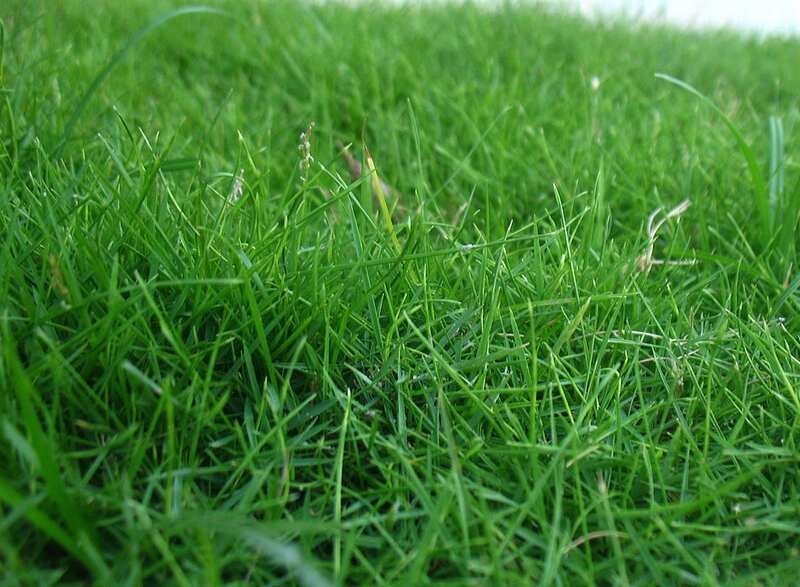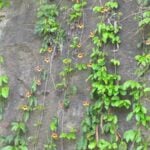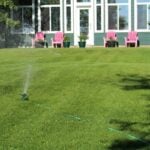
The best grass seed for Mississippi includes the warm-season varieties Bermudagrass, Zoysiagrass, carpetgrass, and centipedegrass. Cold-season grass like tall fescue also grows well in the cooler reaches of northern Mississippi.
The Magnolia State’s hot summers and mild winters mean grass growing is not as difficult here as in other areas of the country, where longer winters and cold spells make lawn care harsher. However, some tips and other information can help you choose the best grass seed and care for your grass so it performs at its best.
Bermudagrass

Bermudagrass is the most popular variety in Mississippi. Homeowners like how its dark green color and thick, full covering create a lush, healthy-looking lawn. Bermudagrass also works well because it adapts to multiple climates and soil types. Therefore, it grows well in the diverse soil types found throughout Mississippi, like clay, silt, and loamy soils.
Bermudagrass is drought-tolerant, so it’s well suited for the hot Mississippi summers and occasional droughts. It’s often grown in coastal areas due to its salt tolerance.
Bermudagrass is not best for places with a lot of shade. It’s one of the least shade-tolerant warm-season grasses and requires the most light out of all the grasses in this article. But that is one of the reasons it is a Mississippi favorite; it needs at least a half day of sun, so it grows well during the sunny summer.
Pros
- Aggressive growth pattern means it covers injured areas quickly, making it ideal for high-traffic areas
- Handles wear and tear well
- Drought-tolerant
- Salt-tolerant
Cons
- Goes dormant in cooler weather
- Requires a lot of water to look good
- High fertilizer needs
- Requires frequent mowing
- Doesn’t do well in shade
Click here for a guide on how to grow Bermudagrass.
- Classification: Warm-season grass
- Spreads by: Stolons and rhizomes
- Shade tolerance: Low; thrives in full sun
- Drought tolerance: High
- Foot traffic tolerance: High
- Soil pH: 6-6.5
- Soil type: Tolerates most soil types
- Maintenance needs: Needs frequent mowing due to fast growth rate; develops a thatch layer easily; needs regular fertilization
- Mowing height: 1-2 inches
- Potential for disease: Good disease resistance; can develop spring dead spot, root decline, dollar spot, leaf spot, large patch, and sheath spot
Grass Seed Options:
– Scotts Turf Builder Bermudagrass (10-lb. bag)
– Hancock Seed Co. Bermudagrass (50-lb. bag)
Zoysiagrass

More Mississippi homeowners in the north and central parts of the state are choosing Zoysiagrass. It has better cold tolerance than some other warm-season grasses, like centipedegrass, and has less of a risk of incurring winter damage.
Zoysiagrass will go dormant when the temperatures begin to cool off. And although Zoysiagrass goes brown in the winter, many homeowners enjoy the color.
Three types of Zoysia species are grown as turfgrass in The Magnolia State:
| Zoysiagrass Species | Cold Tolerance | Texture | Notes |
| Japanese lawngrass (Zoysia japonica) | High | Coarse | Grows as far north as coastal New England |
| Manilagrass (Zoysia matrella) | Intermediate | Intermediate | No limitations on regions for optimal growth |
| Korean velvetgrass (Zoysia tenuifolia) | Low | Fine | Develops significant thatch but is good for an exceptionally dense lawn. Best if grown only in USDA hardiness zones 8a and 8b. |
Pros
- Slow growth habit means it’s low-maintenance
- Requires less mowing and fertilizer than Bermudagrass
- High traffic tolerance
- Growth pattern helps mitigate common Mississippi weeds
- Adapts to a wide range of pH levels
Cons
- Requires sufficient fertilization, watering, and mowing to reduce the risk of pest infestations
- Suffers from rust
- Rotary mowers are vulnerable to damage when grass grows tall unless the blades are sharp. (Best to mow with a reel mower.)
- Doesn’t grow well in clay soil
- Needs well-drained soil to thrive
Here’s a guide on how to grow Zoysiagrass.
- Classification: Warm-season grass
- Spreads by: Stolons and rhizomes
- Shade tolerance: Moderate
- Drought tolerance: Moderate to high
- Foot traffic tolerance: High; recovers slowly
- Soil pH: 6-6.5
- Soil type: Well-draining; some cultivars are more tolerant of a wide range of soils than others
- Maintenance needs: Moderate; low nitrogen fertilization requirements; prone to thatch
- Mowing height: 1-2.5 inches
- Potential for disease: Good disease tolerance; can develop large patch, root decline, spring dead spot, rust, curvularia, and leaf spot
Grass Plug and Seed Options:
– Zoysia Plugs (50 Large Grass Plugs)
– Zoysia Plugs (100 Plugs)
– Zenith Zoysia Grass Seeds (1/8 lb. of seeds)
Carpetgrass

Mississippi winter temperatures can drop as low as 20 to 25 degrees Fahrenheit and lower, so carpetgrass will go dormant and turn brown in the winter. Carpetgrass may not be considered as picturesque as Bermudagrass and Zoysiagrass when it browns. To improve the look of your lawn in the colder months, seed it with a cool-season grass, like tall fescue.
Carpetgrass experiences winter damage in the northern part of the state. While the grass can be grown in this region, it takes more maintenance to keep it healthy. Furthermore, carpetgrass does not grow well in heavy clay soil, like the soil types in the Delta and Blackland Prairie.
Pros
- Low maintenance
- Low fertilizer needs
- Grows well in infertile and acidic soils
- Survives wet environments
Cons
- Winter damage
- Does not grow well in heavy clay soils
- Turns brown in the winter
- Fair stress recovery
- Low drought tolerance
- Poor wear resistance
For more, check out our article on growing carpetgrass.
- Classification: Warm-season grass
- Spreads by: Stolons
- Shade tolerance: Moderate
- Drought resistance: Moderate
- Foot traffic tolerance: Low to moderate
- Soil pH: 5-6
- Soil type: Infertile, moist but not waterlogged, acidic, sandy
- Maintenance needs: Mow weekly to control seed heads
- Mowing height: 1-2 inches
- Potential for disease: Large patch is common
Grass Seed Option:
– Carpetgrass seeds (coated) (2 lbs.)
Centipedegrass

This warm-season grass has a yellow-green hue and prefers the sandy, acidic soil of Southeast Mississippi. Like carpetgrass, centipedegrass doesn’t grow well in heavy clay soils.
Centipedegrass is growing on Mississippi homeowners, especially those who want a low-maintenance lawn. However, it grows slowly, meaning it recovers slowly from injury. It also doesn’t have good wear tolerance. Nevertheless, many appreciate that it rarely exceeds 4 inches in height when neglected and typically suppresses most weeds.
Mississippians living in USDA hardiness zone 7a, which includes parts of northern Mississippi, are advised not to grow common centipedegrass due to its low cold tolerance. It’s susceptible to winter damage in the state’s northern region. However, the centipedegrass varieties Tennessee Hardy, Oklawn, and TifBlair have more cold resistance than common centipedegrass.
Pros
- Low maintenance once established
- Grows well under neglect
- Performs well in acidic, sandy soils
- Crowds out weeds
Cons
- Winter damage when grown in USDA hardiness zones 7a and the northern parts of zone 7b
- Slow stress recovery means it needs regular watering
- Low wear tolerance
- Vulnerable to drought stress
- Not salt-tolerant
- Low foot traffic tolerance
If this is your pick, we have a guide on how to maintain centipedegrass.
- Classification: Warm-season grass
- Spreads by: Stolons
- Shade tolerance: Moderate — at least six hours of full sun per day
- Drought resistance: Low to moderate
- Foot traffic tolerance: Low
- Soil pH: 5-6
- Soil type: Acidic, infertile, at least moderately good drainage (very dense, clay soils produce poor results)
- Maintenance needs: Low mowing frequency
- Mowing height: 1.5-2 inches
- Potential for disease: Good resistance to diseases and insects
Grass Seed Options:
– Gulf Kist Coated Centipedegrass Seeds (1 lb.)
– Scotts EZ Seed Patch and Repair Centipedegrass (3.75 lbs.)
– TifBlair Centipedegrass (5-lb. bag)
Tall Fescue

Photo Credit: Aaron J. Patton, Ph.D. / Turfgrass Extension Specialist at Purdue University
For a grass variety that grows well in the shade, tall fescue is one of the best options. It will perform better and longer in the summer when it is shaded from the sun. This coarse, dark-green, cool-season grass will go dormant in the heat of the Mississippi summers, but it works well in Northern Mississippi on shady yards. However, it thins out in the shade and requires frequent reseeding.
Tall fescue tolerates the droughts Mississippi experiences, just as long as the periods of dryness are short. The grass will turn brown from lack of water, so give it plenty of irrigation to help it maintain its color. Water will also help keep it from going dormant in the summer (see our guide on watering in hot weather).
Pros
- Grows well on shady properties
- Deep root system makes it drought-tolerant
- Does not develop excessive thatch
Cons
- Thins out in the shade
- Needs regular reseeding
- Goes dormant in the summer
- Turns brown if not given adequate water
- Prone to several diseases
For more, check out our article about how to grow tall fescue.
- Classification: Cool-season grass
- Spreads by: Bunch-type grass
- Shade tolerance: Moderate
- Drought tolerance: Moderate
- Foot traffic tolerance: Moderate; recovers poorly
- Soil pH: 5.5-6.5
- Soil type: Fertile; good drainage; adaptable
- Maintenance needs: Frequent mowing; does not produce significant thatch
- Mowing height: 2-4 inches
- Potential for disease: Low to moderate; prone to brown patch, seedling disease, and leaf spot
Grass Seed Options:
– Triple-Play Tall Fescue Grass Seed Blend (5000 sq ft)
– Eretz Kentucky 31 K31 Tall Fescue Grass Seed (choose your size)
– Pennington The Rebels Tall Fescue Grass Seed Mix (7 lb.)
The Best Grass for South Mississippi
South Mississippi or the Mississippi Gulf Coast is a salty environment and is warmer and more humid than the rest of the state. Centipedegrass, carpetgrass, Bermudagrass, and Zoysiagrass perform well in this region. If your yard is prone to salty wind sprays, you may want to choose a grass other than centipedegrass, since it doesn’t tolerate salt air very well.
The Difference Between Warm-Season and Cool-Season Grasses
Mississippi has long, hot summers, relatively mild winters, and a tendency to experience both floods and droughts. Warm-season grasses are best adapted to the area. However, Northern Mississippi is in the transition zone, meaning both warm and cool-season varieties are unable to fully adapt to the area. Cool-season grasses and specific warm-season grasses are better suited for the northern part of The Magnolia State.

- The growth season for warm-season grasses begins late spring and runs until the summer when temperatures typically range between 75 to 95 degrees Fahrenheit. These turf varieties thrive in the warmer temperatures experienced in the lower part of the United States.

- Cool-season grasses grow best in regions of the country where the winters are longer and colder. These turf types are typically found in the northern part of the US. These grasses grow actively between early spring and fall when temperatures are between 55 to 75 degrees Fahrenheit.
How to Choose the Best Grass for Your Mississippi Lawn
Consider these factors to ensure you choose the best grass variety for your yard’s characteristics and your lifestyle:
Shade Tolerance
If you have a shady property or need to plant grass in shady areas of your yard, choose a variety that performs well with minimal sunlight.
Moderate shade tolerance: Turf-type tall fescue, Zoysiagrass, carpetgrass, centipedegrass
Low shade tolerance: Bermudagrass
Drought Tolerance
Mississippi can experience periods of dryness, so it is important to understand how well your grass type withstands droughts.
High drought tolerance: Bermudagrass
Moderate drought tolerance: Zoysiagrass, turf-type tall fescue
Low drought tolerance: Carpetgrass, centipedegrass
Foot Traffic
You’ll want to choose a grass variety that handles foot traffic well if you have children running and playing in the yard or frequent get-togethers on the lawn. Here is how the best grass varieties for Mississippi withstand foot traffic:
High foot traffic: Bermudagrass, Zoysiagrass
Moderate foot traffic: Turf-type tall fescue
Low foot traffic: Carpetgrass, centipedegrass
Maintenance Level
Life is too short to spend it on chores when you’d rather be doing something else. Let’s look at how much upkeep the different turf types need to remain healthy and look their best.
High-maintenance grasses: Bermudagrass, bentgrass
Moderate-maintenance grasses: Turf-type tall fescue,
Low-maintenance grasses: Zoysiagrass, carpetgrass, centipedegrass (once established)
FAQ
Do Kentucky bluegrass and perennial ryegrass grow well in Mississippi?
Kentucky bluegrass is very popular in the northern part of the US. However, in Mississippi, it does not grow well. It does not perform well in the state’s hot summers, and shady areas cannot protect it from the sun because KBG is not very shade-tolerant.
It does not grow well in alkaline soil and needs a slightly acidic environment that is well-drained. So, Kentucky bluegrass would not thrive in areas like the Black Belt (Northeast Prairie) and Central Prairie.
Perennial ryegrass is not suited for any areas of Mississippi as a permanent option but does grow well in all areas as a winter lawn grass.
Is it best to seed or sod to establish a new lawn?
It depends on a few factors, like how quickly you want a lawn and your budget. Seeding takes longer to establish a lawn and more upkeep because the seeds must be planted into the ground and given the care and time to grow into grass. Check out our growing grass seed guide for step-by-step instructions.
Sod is mature grass that is placed on the soil to create an instant lawn, but it is more expensive. Read our guide to find out more about sod for your lawn.
What are the best native plants for Mississippi homeowners?
Cinnamon fern, coreopsis, milkweed, and coneflower are some of the best native Mississippi floras. Check out our article, “The Best Mississippi Native Plants for Landscaping,” for more.
When to Call a LawnStarter Pro
Warm-season grasses grow best throughout most of Mississippi. However, there are some exceptions, like the northern part of the State, where the cold-season variety tall fescue also grows well. Furthermore, the variable soil types can make choosing a turf grass challenging.
You don’t have to figure it out on your own. Call, click, or download our app and let a LawnStarter pro help you. Our experts can also mow, trim, edge, and do all of your lawn care maintenance so you don’t have to.
Main Image Credit: Lawn in front of the Eudora Welty House in Jackson, Mississippi / J R Gordon / Flickr / CC BY 2.0
LawnStarter participates in the Amazon Services LLC Associates Program, an affiliate advertising program. LawnStarter may earn revenue from products promoted in this article.





